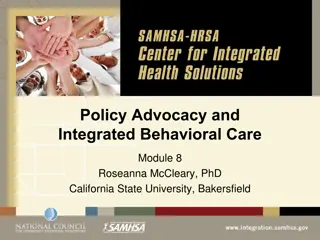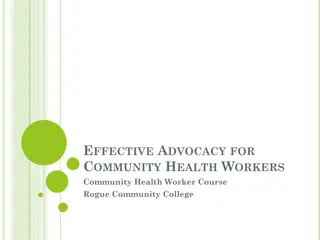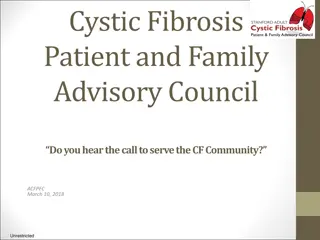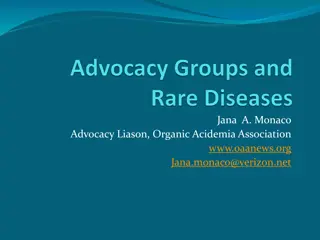Understanding Community Advisory Boards in Patient Advocacy
Community Advisory Boards (CABs) play a crucial role in connecting patient advocates with researchers in the field of therapeutic innovation. They review clinical trial protocols, monitor trials, and educate the community. CABs can be established for specific purposes or therapeutic areas. Different models exist, including therapeutic-specific, research institution-specific, single trial-specific, and industry-initiated CABs. Defining the community for a CAB is essential for its effectiveness.
- Community Advisory Boards
- Patient Advocacy
- Therapeutic Innovation
- Patient Representatives
- Research Collaboration
Download Presentation

Please find below an Image/Link to download the presentation.
The content on the website is provided AS IS for your information and personal use only. It may not be sold, licensed, or shared on other websites without obtaining consent from the author. Download presentation by click this link. If you encounter any issues during the download, it is possible that the publisher has removed the file from their server.
E N D
Presentation Transcript
European Patients Academy on Therapeutic Innovation Participation of Patient Advocates in Community Advisory Boards What are Community Advisory Boards?
Community Advisory Board: a definition European Patients Academy on Therapeutic Innovation In medicines development, a Community Advisory Board (CAB) is a group of patient representatives that serves as a link between a community and researchers. Within clinical development a CAB may review clinical trial protocols and monitor clinical trials and help teach the community about them. The CAB model has also been implemented in areas such as policy making and Health Technology Assessment (HTA). 2
Types of Community Advisory Board European Patients Academy on Therapeutic Innovation Community Advisory Board (CAB) sometimes called Community Advisory Group (CAG) can be long-term institutions or project-based, established for a single purpose such as: for research with a particular target group (e.g. adolescents) for specific studies (e.g. Tuberculosis vaccine studies) for disease-based research (e.g. HIV and co-infections European CAB) 3
Definitions of Community European Patients Academy on Therapeutic Innovation A number of authors offer different definitions of community and who can speak for it. The term community can mean1: a group of people who have a common set of interests, or a common set of characteristics (i.e. living with the same disease, or same age group, etc.) a group of people who live in a common area or location. Another definition is2: A group of people with diverse characteristics who are linked by social ties, share common perspectives, and engage in joint action in geographical locations or settings. 1 AVAC, Civil Society Engagement, http://www.avac.org/civil-society-engagement 2 MacQueen M. et al, What Is Community? An Evidence-Based Definition for Participatory Public Health, Am J Public Health. 2001;91:1929 1938 4
Different CAB models European Patients Academy on Therapeutic Innovation CABs can be established according to different models: Therapeutic area specific: for example, HIV, Chronic myelogenous leukemia (CML), etc. Research Institution specific: for example, a network of researchers running different trials can set up an internal CAB to get advice on different research projects. Single Trial specific: this is usually needed when trial procedures are particularly risky or ethically challenging. Industry initiated: sometimes a pharmaceutical company may promote the establishment of a CAB to get advice on specific issues or on their whole medicines portfolio; in this case, specific procedures to ensure independence should be put in place. 5
Defining Community for your CAB European Patients Academy on Therapeutic Innovation It is important to make sure the CAB membership reflects the community itself. The selection of members to participate in CAB meetings should be based on the meetings objectives. It is also possible to invite non-members, such as minority groups, to best represent the community. 6
What do CABs do in medicines R&D? European Patients Academy on Therapeutic Innovation CABs members are expected to provide advice on a range of topics involved in medicines R&D: Ethics: providing advice about the informed consent process and other ethical aspects of research protocols; Research priorities: discussing the unmet therapeutic need with researchers thus promoting a more focused and efficient scientific approach; Study procedures: enabling study participants to reduce the burden involved in clinical research (i.e. number of study visits, cumbersome procedures, etc.); Information dissemination: improving recruitment strategy, community knowledge about research, and efficient dissemination of the results. The scope of some CABs work goes beyond medicine R&D and includes: access strategy, pricing issues, post-marketing surveillance, etc. 7
What do CABs do? European Patients Academy on Therapeutic Innovation CABs work can be beneficial at any step of patient involvement in medicine R&D. CABs should be established and maintained in accordance with the EUPATI Guidance Documents: Guidance for Patient Involvement in Industry-led Medicines R&D. Guidance for Patient Involvement in HTA. Guidance for Patient Involvement in Regulatory Processes. Guidance for Patient Involvement in Ethical Review of Clinical Trials. EUPATI, Guidance for patient involvement in industry-led medicines R&D, https://www.eupati.eu/patient-involvement/guidance-for- patient-involvement-in-industry-led-medicines-rd/ 9
Are CABs the only way? European Patients Academy on Therapeutic Innovation CABs are the most common form of community engagement in community-based participatory research (CBPR) CBPR aims to understand communities' health priorities, to design research that addresses these priorities, and to involve communities throughout the research process (Israel et al., 1998). Other forms of community engagement may be: hiring community members as project staff, holding face to face public meetings in the community. using digital media. Kennedy C, Vogel A, Goldberg-Freeman C, Kass N, Farfel M. Faculty perspectives on community-based research: I see this still as a journey. Journal of Empirical Research on Human Research Ethics. 2009;4(2):3 16. https://www.ncbi.nlm.nih.gov/pmc/articles/PMC3124219/ 10
Challenges faced by CABs European Patients Academy on Therapeutic Innovation CABs work can face different challenges: 1. Enabling an optimal representation of the community in the CAB 2. Managing internal conflicts whilst recognising different views 3. Establishing and maintaining independence 4. Ensuring funding and sustainability. 11
An example of challenges faced by researchers. European Patients Academy on Therapeutic Innovation In the course of their community-based research projects, CBPR researchers experienced four main types of challenges: 1. defining and representing the community, 2. sharing power in the community-academic partnership, 3. overcoming a history of institutional research in the local community that was not perceived to provide direct benefits to the community, and 4. balancing the competing demands of a career in academia, and working within incentive structures that may not always support community-engaged research. Kennedy C, Vogel A, Goldberg-Freeman C, Kass N, Farfel M. Faculty perspectives on community-based research: I see this still as a journey. Journal of Empirical Research on Human Research Ethics. 2009;4(2):3 16. https://www.ncbi.nlm.nih.gov/pmc/articles/PMC3124219/ 12
References European Patients Academy on Therapeutic Innovation EATG ECAB, The impatient Patient - From Anger to Activism A systematic review of the history, working models, relevance and perspectives of the European Community Advisory Board http://www.eatg.org/wp-content/uploads/2016/05/The-impatient-patient.pdf EUPATI, Guidance for patient involvement in industry-led medicines R&D, https://www.eupati.eu/patient-involvement/guidance-for-patient-involvement- in-industry-led-medicines-rd/ EUPATI, Guidance for patient involvement in ethical review of clinical trials, https://www.eupati.eu/clinical-development-and-trials/guidance-for-patient- involvement-in-ethical-review-of-clinical-trials/ EUPATI, Examples of Patients Involvement, https://www.eupati.eu/tag/patients-involved-case-report/ 13
References European Patients Academy on Therapeutic Innovation Kennedy C, Vogel A, Goldberg-Freeman C, Kass N, Farfel M. Faculty perspectives on community-based research: I see this still as a journey. Journal of Empirical Research on Human Research Ethics. 2009;4(2):3 16. https://www.ncbi.nlm.nih.gov/pmc/articles/PMC3124219/ MacQueen M. et al, What Is Community? An Evidence-Based Definition for Participatory Public Health, Am J Public Health. 2001;91:1929 1938 https://www.ncbi.nlm.nih.gov/pmc/articles/PMC1446907/ Newman SD, Andrews JO, Magwood GS, Jenkins C, Cox MJ, Williamson DC. Community advisory boards in community-based participatory research: a synthesis of best processes. Prev Chronic Dis 2011;8(3):A70. https://www.cdc.gov/pcd/issues/2011/may/10_0045.htm Quinn SC. Ethics in public health research: protecting human subjects: the role of community advisory boards. Am J Public Health. 2004;94:918 922. https://www.ncbi.nlm.nih.gov/pmc/articles/PMC1448363/ 14
References European Patients Academy on Therapeutic Innovation Silvestre AJ, Quinn SJ, Rinaldo CR. A Twenty-Two-Year-Old Community Advisory Board: Health Research as an Opportunity for Social Change. J Community Pract. 2010;18:58 75. https://www.ncbi.nlm.nih.gov/pmc/articles/PMC2879669/ South African National Health Research Ethics Council (2012). Guidelines for Community Advisory Groups. NHREC https://www.ru.ac.za/media/rhodesuniversity/content/ethics/National%20Gui delines%20for%20Community%20Advisory%20Groups%20for%20Researc h%20(2012).pdf Strauss R, Sengupta S, Quinn S, Goeppinger J, Spaulding C, Kegeles SM, et al. The role of community advisory boards: involving communities in the informed consent process. American Journal of Public Health 2001;91(12):1938 1943. https://www.ncbi.nlm.nih.gov/pmc/articles/PMC1446908/ 15























